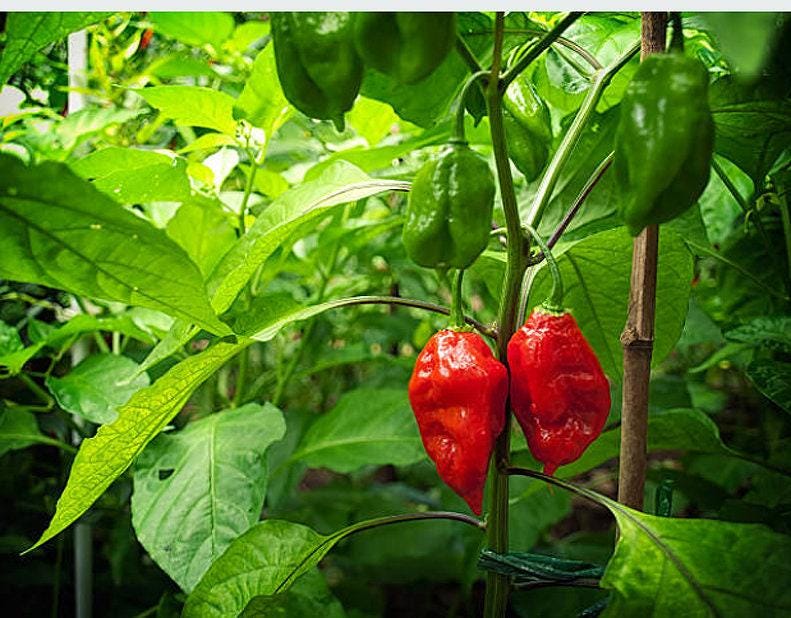Best tasting super hot pepper - CALL THE FIRETRUCK HOT! World's Hottest Pepper in the 2007 Guinness Book of World's Records, about 300 times hotter than a jalapeno! 2½-3" x 1" wrinkled, teardrop lime green fruit ripens to red, yellow, orange or chocolate. Start indoors earlier than other peppers as they are very slow to germinate. Great for salsa, chutney, jerk sauces, and ghost pepper jam! Used in non-lethal hand grenades and pepper spray. 855,000 – 1,041,427 SHU
The ghost pepper is also known by the following names – Naga Jolokia, Bhut Jolokia, Bih jolokia, Nagahari, Raja Mircha, Raja chilli, Borbih jolokiai or Ghost Chili. Note: “Naga” mean “Cobra Snake” in Sanskrit.
This hot pepper also has a side use in Indian cooking. In addition to being a common household ingredient in certain parts of India and Bangladesh, it has also been used as a homeopathic remedy for stomach pain, a way to beat the summer heat (when the bhut jolokia is eaten, the partaker will usually start to sweat quite a bit, which will ultimately lead to a decrease in body temperature). It has even been used as a weapon – locals of northeastern India smear their fences with it to keep elephants away, and the pepper has even been used in smoke bombs.
The official heat scale for chilies is known as the Scoville scale, developed by Wilbur Scoville in 1912.To give you an idea of the range of heat in an habanero: a sweet pepper scores 0 on the scale, jalapeño and chipotle chilies score anything between 2,500 to 10,000 and habaneros score 200,000 to 300,000!
~ sowing ~
* **Very hot peppers are difficult to germinate, it is common for germination rates to hover around 60%.
Capsiucum chinense strains require a great deal of attention during the germination process. Moisture and a constant and consistent heat range MUST be maintained. Start early indoors and transplant well after last frost. Lower temperatures permanently reduce plant productivity.
Start indoors in March. Place the seeds in sterile media and cover 1/4” deep. Provide 85°F bottom heat to accelerate germination, bright light and keep moist at all times. Keep soil as warm as possible. The seed is slow to germinate (up to 3 weeks).
Transplant seedlings into 3" pots and grow until there are 6 true leaves on the plant. For greatest possible flower set, try to keep them for 4 weeks at night, about 61-64°F and day time temps of 64-75°F. Plant them directly into rich soil, 30” apart or into containers.
~ growing ~
Feed and water pepper plants regularly throughout the growing season to prevent the flower buds from dropping. Provide a thick mulch of organic matter around the base of the plants to help conserve moisture and reduce weed growth. In greenhouses, maintain high humidity by damping down paths daily.
Soil should have abundant phosphorus and calcium, so add lime and compost to the bed at least three weeks prior to transplanting. Mix ½ cup of complete organic fertilizer beneath each plant. Though peppers will tolerate dry soil, they will only make good growth if kept moist. Harden off before planting out in June, 30-60cm (12-24″) apart. Water in with kelp-based fertilizer. Using plastic mulch with a cloche can increase the temperature few degrees.
~ harvesting ~
When harvesting, take care to avoid touching the interior of any broken peppers, as the capsaicin is an extreme irritant, especially to the eyes. Wash hands thoroughly after harvesting, or wear gloves to harvest peppers. Harvesting hot peppers is basically a matter of personal preference. Generally, the longer the peppers mature on the vine, the hotter they will taste. Mature peppers, however, signal the plant to stop producing; if the peppers are picked when still at the green stage, the plant will go on producing. Always use a knife or scissors to remove peppers to prevent damage to the fragile stems.
Harvest peppers singly by cutting them from the plant by with pruning clippers or pull the entire plant when full of ripe peppers, and hang upside down in the kitchen for use all year long. Peppers grown outdoors must be harvested before the first frosts.



















